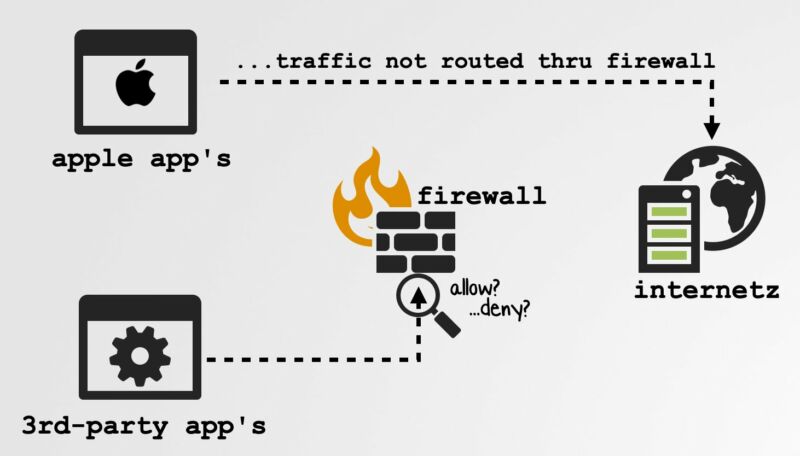
Firewalls aren’t just for corporate networks. Large numbers of security- or privacy-conscious people also use them to filter or redirect traffic flowing in and out of their computers. Apple recently made a major change to macOS that frustrates these efforts.
Beginning with macOS Catalina released last year, Apple added a list of 50 Apple-specific apps and processes that were to be exempted from firewalls like Little Snitch and Lulu. The undocumented exemption, which didn't take effect until firewalls were rewritten to implement changes in Big Sur, first came to light in October. Patrick Wardle, a security researcher at Mac and iOS enterprise developer Jamf, further documented the new behavior over the weekend.
In Big Sur Apple decided to exempt many of its apps from being routed thru the frameworks they now require 3rd-party firewalls to use (LuLu, Little Snitch, etc.) 🧐
— Patrick Wardle (@patrickwardle) November 14, 2020
Q: Could this be (ab)used by malware to also bypass such firewalls? 🤔
A: Apparently yes, and trivially so 😬😱😭 pic.twitter.com/CCNcnGPFIB
“100% blind”
To demonstrate the risks that come with this move, Wardle—a former hacker for the NSA—demonstrated how malware developers could exploit the change to make an end-run around a tried-and-true security measure. He set Lulu and Little Snitch to block all outgoing traffic on a Mac running Big Sur and then ran a small programming script that had exploit code interact with one of the apps that Apple exempted. The python script had no trouble reaching a command and control server he set up to simulate one commonly used by malware to exfiltrate sensitive data.
“It kindly asked (coerced?) one of the trusted Apple items to generate network traffic to an attacker-controlled server and could (ab)use this to exfiltrate files,” Wardle, referring to the script, told me. “Basically, ‘Hey, Mr. Apple Item, can you please send this file to Patrick’s remote server?’ And it would kindly agree. And since the traffic was coming from the trusted item, it would never be routed through the firewall... meaning the firewall is 100% blind.”
Wardle tweeted a portion of a bug report he submitted to Apple during the Big Sur beta phase. It specifically warns that “essential security tools such as firewalls are ineffective” under the change.
Apple has yet to explain the reason behind the change. Firewall misconfigurations are often the source of software not working properly. One possibility is that Apple implemented the move to reduce the number of support requests it receives and make the Mac experience better for people not schooled in setting up effective firewall rules. It’s not unusual for firewalls to exempt their own traffic. Apple may be applying the same rationale.
But the inability to override the settings violates a core tenet that people ought to be able to selectively restrict traffic flowing from their own computers. In the event that a Mac does become infected, the change also gives hackers a way to bypass what for many is an effective mitigation against such attacks.
“The issue I see is that it opens the door for doing exactly what Patrick demoed... malware authors can use this to sneak data around a firewall,” Thomas Reed, director of Mac and mobile offerings at security firm Malwarebytes, said. “Plus, there’s always the potential that someone may have a legitimate need to block some Apple traffic for some reason, but this takes away that ability without using some kind of hardware network filter outside the Mac.”
People who want to know what apps and processes are exempt can open the macOS terminal and enter sudo defaults read /System/Library/Frameworks/NetworkExtension.framework/Resources/Info.plist ContentFilterExclusionList.
NKEs
The change came as Apple deprecated macOS kernel extensions, which software developers used to make apps interact directly with the OS. The deprecation included NKEs—short for network kernel extensions—that third-party firewall products used to monitor incoming and outgoing traffic.
In place of NKEs, Apple introduced a new user-mode framework called the Network Extension Framework. To run on Big Sur, all third-party firewalls that used NKEs had to be rewritten to use the new framework.
Apple representatives didn’t respond to emailed questions about this change. This post will be updated if they respond later. In the meantime, people who want to override this new exemption will have to find alternatives. As Reed noted above, one option is to rely on a network filter that runs from outside their Mac. Another possibility is to rely on PF, or Packet Filter firewall built into macOS.
Listing image by Apple
reader comments
148